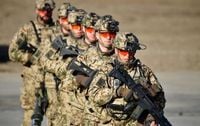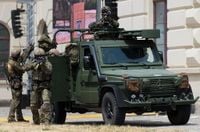Germany is bracing for the unthinkable. As tensions mount on NATO’s eastern borders and the specter of a possible large-scale conflict with Russia grows, German military planners are preparing for a scenario that would have seemed unimaginable just a few years ago: treating up to 1,000 wounded soldiers every single day. This sobering estimate, confirmed by German Army Surgeon General Ralf Hoffmann in multiple interviews with Reuters and other outlets, has sent ripples through military and civilian circles alike.
The preparations come amid a backdrop of escalating incidents and warnings. NATO has long cautioned that Moscow could be capable of launching an attack on the alliance as soon as 2029. While the Kremlin has repeatedly denied any intent to wage war against NATO, recent deliberate violations of alliance airspace by Russian planes and drones—particularly in the Baltics and Poland—have only heightened anxieties. According to Reuters, these incursions have prompted officials and military planners to take the threat of escalation more seriously than ever before.
"Realistically, we are talking about a figure of about 1,000 wounded soldiers per day," Hoffmann told Reuters. He emphasized that the actual number would depend heavily on the intensity of the fighting and which military units were involved. The grim projection is based on lessons learned from the ongoing war in Ukraine, which has become Europe’s largest conflict since World War II.
Since Russia’s full-scale invasion of Ukraine in 2022, European militaries—including their medical services—have been forced to rethink and ramp up their preparations for potential conflict with Moscow. Germany is no exception. The Bundeswehr, Germany’s armed forces, is now adapting its medical training and protocols, incorporating hard-won lessons from the Ukrainian frontlines. As Hoffmann explained, "The nature of warfare has changed dramatically in Ukraine." Gone are the days when gunshot wounds were the primary concern. Instead, blast injuries and burns caused by drones and so-called loitering munitions have become the new norm.
The Ukrainian experience has been particularly instructive for German planners. Ukrainian soldiers describe a corridor roughly 10 kilometers wide on both sides of the front line as a "death zone" or "kill zone." This area is saturated with remotely piloted unmanned aerial vehicles (UAVs) deployed by both sides, which can quickly spot and neutralize targets. Hoffmann noted, "The Ukrainians often cannot evacuate their wounded fast enough because drones are buzzing overhead everywhere." This constant aerial threat means that injured personnel sometimes require prolonged stabilization directly on the frontline—sometimes for hours—before they can be safely evacuated.
As a result, Germany is considering a variety of flexible options for transporting the wounded. Hospital trains, buses converted into mobile medical units, and expanded air medical evacuation capabilities are all on the table. Hoffmann highlighted the effectiveness of hospital trains, noting that Ukraine has already used them to good effect. The plan is for wounded soldiers to receive initial treatment at the frontline, after which they would be transported back to Germany for further care—primarily in civilian hospitals.
The scale of the potential medical response is staggering. Hoffmann estimates that around 15,000 hospital beds would be needed to accommodate the influx of wounded soldiers. This is a significant but manageable portion of Germany’s total hospital capacity, which stands at up to 440,000 beds. The German military medical service, currently numbering 15,000 personnel, will be expanded to meet these future needs.
Other European countries are also stepping up their preparations. According to Metro, the continent is not only increasing military spending but is also considering measures such as the reintroduction of conscription. Medical services are being enhanced and modernized, drawing directly from the lessons of Ukraine’s battlefields. The shift from traditional gunshot injuries to the complex trauma caused by drones and explosive devices has forced a complete rethink of battlefield medicine.
The recent uptick in Russian provocations has only added urgency to these efforts. Just days ago, three Russian MiG-31 fighter jets entered Estonian airspace, remaining for 12 minutes before being forced to withdraw. The incident has sparked NATO Article 4 consultations and is set to be discussed at the United Nations Security Council. Kremlin spokesperson Dmitry Peskov dismissed Estonia’s claims as "empty, unfounded and a continuation of a completely reckless pattern of escalating tensions and provoking a confrontational atmosphere." Yet for NATO planners, these words ring hollow against the backdrop of repeated airspace violations and the ongoing war in Ukraine.
Meanwhile, Russian President Vladimir Putin has once again issued thinly veiled threats to the West. On September 22, 2025, he stated that Moscow would respond to threats "not with words but with military force," even alluding to the possibility of nuclear weapons. U.S. Special Envoy Keith Kellogg has suggested that Putin’s ambitions to revive an empire further increase the risk of a Russian attack on a NATO country.
For Germany, the stakes could hardly be higher. The country’s medical planners are acutely aware that the lessons of Ukraine may one day need to be applied much closer to home. The Bundeswehr is working to ensure that it can provide immediate, effective care to wounded soldiers, even under the most challenging conditions. This includes not only expanding the medical corps but also integrating civilian hospitals and resources into the broader response plan.
Even as Moscow continues to reject any suggestions that it is preparing for war with NATO, the evidence on the ground tells a different story. The deliberate violations of NATO airspace, the intensification of drone warfare, and the ongoing brutality of the conflict in Ukraine have combined to create a sense of urgency that is impossible to ignore. The German military’s preparations may seem grim, but they are a necessary response to a rapidly changing security environment.
As Europe watches and waits, one thing is clear: the lessons of Ukraine are being studied with a determination born of necessity. Germany’s planners hope that these preparations will never be needed, but they are leaving nothing to chance. The hope is for peace, but the readiness is for war—should it ever come.



